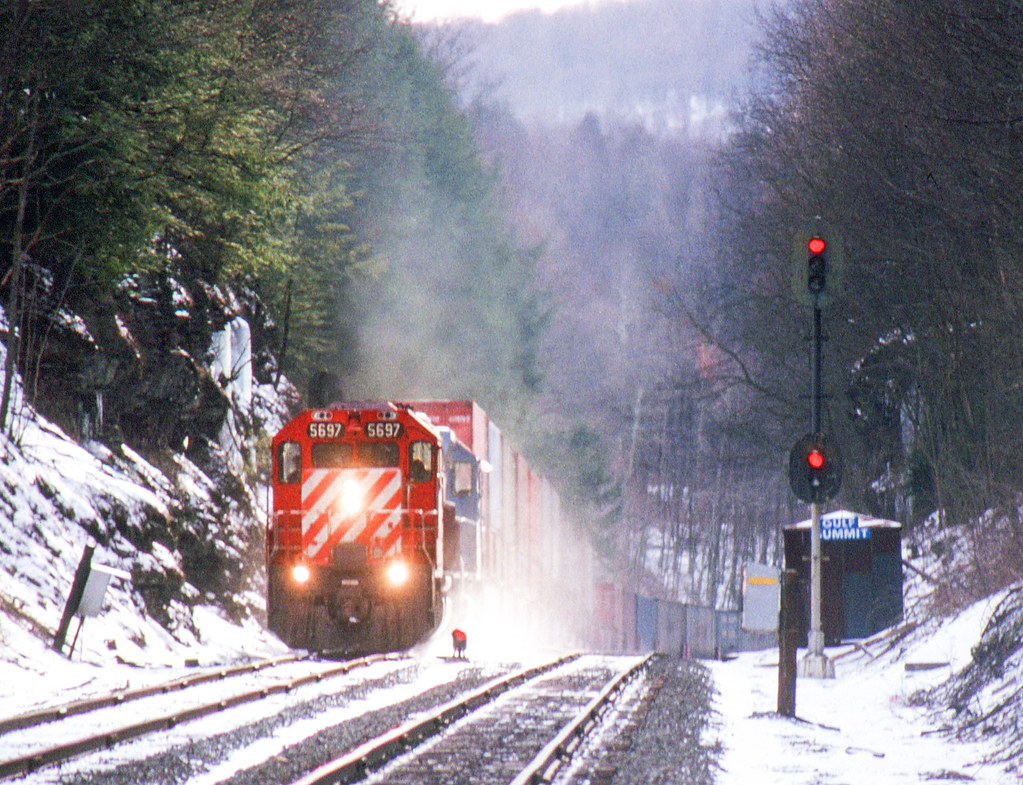#canadian pacific railways
Text
"King’s administration, however, had not shown any sign of bending much in the CPR’s direction. Indeed, his government implemented
Borden’s railway legislation, passing the Canadian National Railways
Act of 1919, and appointed an outstanding executive, Sir Henry Thornton, to the helm of the CNR in 1922. Thornton was a U.S.-born railway executive and engineer by background who had moved up the corporate hierarchy of the Pennsylvania Railroad before taking a general manager’s position with the Great Eastern Railway in England, at the time the world’s largest commuter system. After the outbreak of war, Thornton’s technical knowledge was drawn upon in the British war effort as he was cast into the role of inspector-general for the British Expeditionary Forces and made “responsible for operation of the whole intricate system upon which the existence of the British line depended.” Embracing advanced views on unions and labour relations, Thornton was respected by Great Eastern Railway employees and was a personal friend of J.H. Thomas, a major figure within Britain’s national railway union. It was Thomas who mentioned the CNR position to Thornton – a position that had opened up following the resignation of D.B. Hanna, who resigned in protest over “political interference” in CNR affairs exercised by the recently elected Liberal administration of Mackenzie King. Knighted for his war services, the affable
Thornton had gained a reputation as a railway “superman,” though his position with the Great Eastern had been extinguished after the government passed legislation to reorganize the British railway system. Thornton was quick to charm the Canadian public as well as CNR employees. Thornton “has quite won the hearts of all who have met him,” exclaimed Flavelle. More troubling to Flavelle and moderate progressives such as Dafoe, however, were Mackenzie King’s blatant political appointments to the CNR board. This was a departure from Borden’s ideal of nonpartisan, businesslike operation. Nonetheless, with Thornton at the helm, the CNR had behind it a power of incalculable importance: popular opinion.
Beatty was quick to see public relations as the most significant challenge facing the CPR. In 1923, encouraged by Beatty’s recent public pronouncements, Lord Atholstan commenced his “Whisper of Death” campaign in the Montreal Star, which forecast an oncoming deluge resulting from a mounting national debt, made intolerable by
costs associated with the CNR. Beatty considered Thornton nothing more than a “showman,” and sought to meet his challenge and correct “political misrepresentation” about the railways through an institutional advertising campaign. (Thornton, for his part, considered Beatty “a lawyer [and] not a railway man.” ) Indicative of this public relations drive, Dafoe reported in the summer of 1925 that
“unfair competition invariably comes up” in discussions with high CPR officials; “[t]hey hope for the Shaughnessy plan or a merger.” In April, Clifford Sifton reported: “I do not think the Canadian Pacific has ever been as active in propaganda as it is now. Their intrigues and efforts to influence official opinion are in evidence everywhere.” Sifton asked Dafoe to have the Winnipeg Free Press “declare war on the scheme and fight it out.”
This drive had its effect in Ottawa, where a Senate committee was established to investigate the railway question in 1925. At the committee’s closed-door hearings, Beatty and Sir Herbert Holt presented cases for railway amalgamation so similar that a summary of the proceedings described their presentations as one position. The Senate proved particularly responsive to CPR influence, and the committee’s report presented an opinion generally in line with Beatty’s case, which Beatty himself would reference in arguing for railway unification in the future. Beatty and Holt, as we have seen, met with King the same summer to discuss railway policy, and Beatty continued to press King to leave the door open for railway unification later in the year. But the political bagmen who inhabited the Senate found it easier to embrace railway consolidation than the MPs who counted on popular support in their constituencies.
This was somewhat stifling to the aspirations of Beatty and his moneyed allies. With neither major political party embracing his position on the railway question, Beatty remained “neutral” in the 1926 federal election, preferring to support favoured individuals in both major parties. While Beatty finessed his way around Ottawa, much of the railway battle was being waged in direct business competition, made more lucrative by the boom at the end of the 1920s as the two companies engaged in competition through line extensions, hotel construction, expansion of shipping fleets, and improvements in commuter services. While Beatty advocated consolidation of the two competing systems under private ownership, economic expansion during the 1920s made competition a viable option. Indeed, Beatty reported that $353,346,450 in dividend payments were distributed to common and preferred shareholders during the period from 1918 to 1930, representing 85 per cent of the company’s total earnings “after deducting fixed charges and pension fund appropriations.”
Thornton, meanwhile, modernized the CNR and emerged as a national icon of sorts, emblematic of the possibilities of public enterprise and cooperation between the state, capital, and labour, culminating in Thornton’s address at the American Federation of Labor’s international convention in 1929 in Toronto, where Thornton proclaimed the beginning of “a new labor era.” The “very particular conjunctures of context, character, and circumstance” that underpinned Thornton’s rise, as Allen Seager has observed, disintegrated with the arrival of the Great Depression. Thornton would be one of its first and most public victims, a public sacrifice encouraged by Beatty as he moved even deeper into political activism.
The Duff Commission and “the Tragedy of Henry Thornton”
Meighen, Roger Graham has written, “was not spared the intrigues of
the Montreal tycoons” as talk that R.B. Bennett would be his successor emerged in early 1926; Bennett was “known to hold more ‘businesslike’ opinions about railway matters” than Meighen, whom Bennett once famously described as “the gramophone of Mackenzie and Mann.” Bennett’s election as leader of the Conservative Party in 1927 was an encouraging sign and a small victory for Beatty and St James Street. They respected the independently wealthy Bennett, believing him to be above petty politics; they shared his deep sense of loyalty to the British Empire; and they felt assured about his protectionist tariff policies. “St. James Street favours Bennett because of his protectionist policies,” wrote Prime Minister King pessimistically before the 1930 election. King also learned that “Beatty was favourable to Bennett’s views.” The list of Montreal donors to Bennett’s campaign, observed historian Larry Glassford, “read like a Who’s Who of the Montreal financial and industrial establishment.”
Formerly the chief western solicitor of the CPR and a major shareholder in the Royal Bank, Bennett’s immersion in business and his history with the CPR certainly helped to make him a more reliable candidate for wealthy Montreal residents – but on the campaign trail such connections were a potential liability. With his proclamation “Amalgamation never, competition ever” in a campaign speech, Bennett sounded publicly his independence from Beatty in an attempt to assure western voters that he would not cede a railway monopoly to the CPR. Popular appeal again seemed to trump Beatty’s long-term goals. The seeds of future conflict between Bennett and Beatty were planted even before the electoral triumph of the Bennett Conservatives in 1930.
Canada had more railway mileage per capita than any other nation
by the 1930s. The financial strain of maintaining two competing national lines had seemingly resolved itself during the boom years of
the late 1920s, only to reemerge as a sudden crisis once the economic slump set in. The financial position of the CPR worsened: in the first half of 1931, the CPR reduced dividend payments and soon after suspended payments altogether. Worse still was the position of the CNR, which was already weighed down by an unwieldy capital structure that included old debts accumulated by Mackenzie and Mann and the Grand Trunk. Company earnings fell by $46,249,000, and Thornton attempted cost-cutting measures without implementing wholesale layoffs.
Philosophically opposed to public enterprise, Bennett viewed Thornton as a creature of the King government; and he supported a campaign that conflated Thornton’s lavish private lifestyle with his management of the CNR. While in London, England, in October 1930, Prime Minister Bennett wrote his minister of railways and canals, R.J. Manion, about the shopping activities of Thornton’s wife:
President’s wife here purchasing furniture. President cabled her improvements would cost eighteen thousand dollars and she must spend less for furniture. She says building requires improvements. Whatever action you take entirely satisfactory. I was only desirous [to] communicate casual information.
The CNR directors had approved funds for Lady Thornton to furnish
their Pine Avenue home “in a manner appropriate for the residence of
a president.” But, having received this “casual information” from Bennett, Manion reneged on the agreement. Thereupon Sir Henry perceived that “a concerted plot to ruin his personal reputation” was in the works. He pressed Manion in December to honour the agreement that $20,000 in CNR funds be made available for renovations to his house, explaining that he was “very hard up, stock losses, etc.” Manion did not bend and described his reply to Bennett:
I told him that if the case came up in the House I wanted to be able to say that we had nothing to do with the matter – that the whole arrangement had been made under the previous administration.
Thornton would serve as a sacrificial lamb for the supposed improprieties of the King administration.
The following year the Railway Committee of the House of Commons provided new opportunities to undermine Thornton’s public reputation and associate him with the supposedly spendthrift ways of the Liberals. Manion, R.B. Hanson of New Brunswick, and Dr Peter McGibbon, MP for Muskoka-Ontario, were among the most active Conservative members to tar Thornton in the House, citing imprudent company expenditures on hotels, suggesting (falsely) exorbitant company salaries, and drawing attention to Thornton’s salary and personal expense account. Though Beatty admitted the unfairness of some of the attacks levelled against Thornton, he also recognized new political opportunities on the horizon.
Upon Beatty’s suggestion, a beleaguered Thornton called for the
formation of a royal commission to study the railway question. And though Beatty and Holt complained about delays in getting the commission established, the Duff Commission was finally formed in November. Before the commencement of the commission’s hearings, Beatty was “very hopeful that something constructive” could be achieved and lauded its personnel as “really outstanding.” Chaired by Supreme Court Judge Lyman Duff, the commission included six other prominent figures with weighty business – and some academic – credentials: Joseph Flavelle; Beaudry Leman of Montreal, general manager of the Banque Canadienne Nationale and president of the Canadian Bankers’ Association; U.S. railway executive Leonor Fresnel Loree, president of the Delaware and Hudson Railway Company; Lord Ashfield, head of London’s underground system, the Metropolitan Railways; Walter Charles Murray, president of the University of Saskatchewan; and the Shediac, New Brunswick, physician John Clarence Webster, a respected Conservative, museum patron, and personal friend of Howard P. Robinson.
From his office in Winnipeg, Dafoe reflected upon the significance of the commission’s establishment. “Perhaps I am getting too suspicious in my old age,” he wrote Free Press correspondent John A. Stevenson
but I have a most decided ‘hunch’ that this Commission was appointed to do a particular chore, and that with perhaps two exceptions its members know what the chore is to be. I think the linked money powers in Canada and the United States, with all their subordinate and associate interests, have decided that the time is opportune to oblige Canada to remove her desire to own and operate her own railways.
Dafoe believed that – as part of this plot to gut the CNR – the same tactic deployed in England to dislodge the Labour government might be deployed in Canada: “National Government.”
Had Dafoe become “too suspicious” in old age? Not entirely. The
ever-domineering Bennett had taken a personal interest in the formation of the commission and appeared to be in closer contact with St James Street than the responsible minister, Manion. Winnipeg Free Press correspondent Grant Dexter reported on 15 November that Manion was in “complete ignorance” about the commission’s personnel, but two weeks earlier a private memorandum written by Floyd Chalmers of the Financial Post revealed that Sir Herbert Holt was up to date on recent developments in the selection of commission personnel. “I want to take back anything about believing that amalgamation is off,”
wrote Dexter.
Meanwhile, Thornton’s experience at the hands of the Conservatives had led him to an about-face: in a meeting with Dafoe at Winnipeg’s Fort Garry Hotel on 12 October, Thornton lamented that he had lost faith in the ideal of public enterprise – the CNR, in the interest of its own survival, would have to come under the control of some form of unified management along with the CPR. He told Dafoe that he and Beatty had been working on such a plan together, a fact later confirmed by Lady Thornton. After Thornton’s death, his biographer, D’Arcy Marsh, would write (in 1934) that Thornton had been made “constitutionally incapable” of opposing Beatty, and Dexter believed that Thornton had sold out to Beatty to save his job. Dafoe, Marsh, and Dexter were overly cynical in assessing Thornton’s actions. And though Dafoe’s suspicions had some basis, he greatly exaggerated the level of coordination between Bennett and Beatty.
The proceedings of the Duff Commission commenced on 4 December 1931 with the commissioners interviewing Sir Henry Thornton in a session closed to the public – as was the testimony of all senior railway and government officials. Thornton proposed the establishment of a ten-person “superboard,” consisting of the presidents of each railway company, two Liberal, two Conservative, and two Progressive representatives, a representative of labour, and a representative of the minister of railways and canals. Though Dafoe and others, not privy to his testimony at the time, might have considered it something of a sellout, such judgments are overly harsh. Thornton believed the board, which would oversee both railways and enforce cooperation, would be able to conciliate various interest groups, and his plan thus attempted to establish a mechanism whereby a form of democratic control over the management of the country’s railways would obtain.
It was Thornton’s embrace of the principle of democratic control that set him apart from Beatty – and here Thornton was steadfast. The very goal of exercising democratic control over Canada’s railway systems was thought dubious by commission members, however. Commissioner Loree asked CNR vice-president S.J. Hungerford whether “it be a fair statement to make that a democratic form of government is no competent agency to carry on the railroad business?” To Hungerford’s assertion that “[w]e are seeking to do it,” Loree replied: “But are they doing it? The records do not show they are, because they are going behind every year.”
With the questioning at times threatening to transgress the line of
gentlemanly decorum, Thornton stressed that management of the CNR was a matter of public policy and thus did not necessarily need to justify itself on the basis of profits and losses. In response to a statement by Joseph Flavelle that such an enterprise should not be maintained, Thornton asserted that it was “a matter for the Canadian people to decide.” Beatty appeared before the commission the next day and presented a case that was ideologically much easier for the commissioners to appreciate.
If, on one hand, the privately owned system finds it is unable to maintain its credit in an unequal struggle with the long purse of the state,” Beatty said before the commission, “a grave injustice will be done to the shareholders of a corporation which has fulfilled its fifty-year old contract with the nation, and which has made its full contribution to the upbuilding [ sic ] of the Dominion. Such a consummation would cause most serious injury to the reputation of this young country as a field for private capital.
The cases of Beatty and Thornton differed at a fundamental level, centring not only on the appropriate role of the state in the nation’s economic life but on the appropriate role of public opinion in shaping economic policy. Beatty opposed government intervention, except in a helping role to private capital – steamship subsidies and protective tariffs, for example (which the CPR benefited from). He was also generally dismissive of popular opinion. Thornton, he believed, had succeeded by “showmanship” and “mob appeals.” The deluded public, in Beatty’s estimation, deserved only a very limited role in deciding public policy, and, as we shall see, he turned to “educational” work to address this issue. Thornton, by contrast, accepted some degree of “political” interference in economic affairs as inevitable under any democratic government. “After all in any form of popular government it must be accepted as axiomatic that the business of government is politics and,” Thornton stated before the commission on 4 January 1932, “irrespective of whether one likes it or not, politics is something with which a government must reckon in all its activities.”
Though commission members disliked the idea of public influence over railway management, a view that would be plainly expressed in their report, they were at least equally concerned with the prospect
of leaving the nation’s railways in the hands of a private monopoly.
Beatty proposed a “unification” plan of the two systems under CPR
management that would maintain separate ownership: CPR personnel would act as trustees of the government’s property. Commissioners Flavelle and Loree expressed concern over the de facto monopoly that Beatty’s plan would create. (Beatty privately dismissed Flavelle’s business philosophy, which stressed the role of competition, as “the Flavelle school of ruthless business brutality.” ) Commissioner Webster was somewhat less worried about monopoly.
“The fear of monopoly did not terrify me, as it so strongly impressed Sir Joseph,” he wrote to Meighen in November 1932, “nor did I shrink from submitting the responsibility of conducting so great an undertaking to a single management.” Beatty did not try to hide the monopoly implications of his plan but rather defended the principle of monopoly itself, arguing that “some of the most efficient, most widely administered and most publicspirited public corporations on this continent are monopolies.” “They are in the main,” he continued, “successful, efficient and progressive, and they are administered by men of high character and great ability.” For Beatty, who believed business enterprise to be a form of public service, the most important factor was the quality of business leadership. Since management would be composed of “business statesmen of the highest type,” he did not believe the “question of autocracy” could arise.
Beatty appeared before the commission again on 19 February and
presented a memorandum outlining the benefits of unification, in which he reiterated the need to impose businesslike management over the country’s railways. Asked by commissioner Loree whether a board of directors consisting of CPR and government representatives might successfully manage a unified system, Beatty foresaw two problems. First, the government would be exercising too much active influence in railway matters; second, government involvement would render “doubtful the type [of individuals] that would be selected for appointment to the Board.” Such an arrangement could only be successful if independence from the government were established; Beatty suggested an independent tribunal might select government representatives from “the Canadian Bankers Association, the Canadian Chamber of Commerce and a Judge of the Supreme Court” and be “certain to get the type of men whose ability would justify the selection.”
Beatty’s formulations were latently elitist and antidemocratic: “quality” leadership was presumed to reside in the upper echelons of the business community, and management of the railway system could not be entrusted to any other segment of the population – indeed, it was necessary to insulate such leadership from the pressures of popular opinion. According to Beatty’s beliefs, efficient
railway policy required that it not be formulated outside the meritocratic order that decided success or failure in private enterprise; “political” interference was unacceptable. Beatty was not unique in this mindset; the commission’s report echoed similar sentiments.
The commission’s proceedings prefaced Thornton’s final fall from grace in public life. Thornton had been divorced and quickly remarried (to a much younger woman) several years earlier, and he was known to enjoy nightlife. These were not important problems while the CNR was operating at a profit, but once that changed, Thornton’s personal life was conflated with his management style to devastating effect. He managed the railway the way he lived, his detractors claimed. Called once again before the House of Commons to testify, the gentlemanly decorum of the commission hearings evaporated, Thornton was subjected to a verbal assault by R.B. Hanson. Thornton’s public tarring eroded his political support in the House of Commons. Teetotaller, opposition leader, and political acrobat Mackenzie King acquiesced to this portrayal of Thornton, writing in his diary: “The truth is Thornton has not measured up of late, has drunk too much – far too self-indulgent.” Thornton would later write to King that he had departed from Ottawa under the auspices of a “reign of terror,” “always ‘shadowed’ by a detective.” “The Canadian Pacific Ry. has … exercised a sinister influence in Canadian politics – It has never hesitated at bribing + corruption in all its forms and it represents the worst type of predatory capitalism,” Thornton wrote to King the following day. “It has ruined men.” Undoubtedly, Thornton counted himself among the “ruined men”: “I feel fairly certain I might have remained where I was had I cared to go along with Beatty.”
- Don Nerbas, Dominion of Capital: The Politics of Big Business and the Crisis of the Canadian Bourgeoisie, 1914-1947. University of Toronto Press, 2013. p. 125-133.
#canadian pacific railways#canadian national railways#railway construction#track laying#train stations#railway capitalism#great depression in canada#the pressures of the great depression#capitalism in crisis#capitalism in canada#railway company#royal commission#canadian politics#canadian elite#canadian history#dominion of capital#mackenzie king#r. b. bennett
0 notes
Text

Susquehanna
N.Y.S.& W. EMD GP18's 1804 & 1800 head West with a three car train.
Little Ferry, New Jersey
June 1994
#nys&w#susquehanna railway#cp#canadian pacific#1994#trains#freight train#history#little ferry#new jersey
70 notes
·
View notes
Text




For a lifetime of memories, cross the Rocky Mountains on the CPR
#Rocky Mountains#Canadian Pacific Railway#Canadian Rockies#luxury train#dome cars#scenery#landscapes#CP Rail#CPR#Rocky Mountaineer#train travel#Trans-Canada#Alberta & BC
19 notes
·
View notes
Photo

‘Travel Canadian Pacific Across Canada!’
Canadian Pacific Railway travel poster (c. 1940). Artwork by Peter Ewart.
#1940s#vintage poster#vintage travel poster#canada#Peter Ewart#canadian pacific#canadian pacific railway#trains#train#locomotive#travel#tourism#holiday
368 notes
·
View notes
Text

Canadian Pacific 3065 (EMD GP38-2) leaving the grain elevator in Rockglen, Saskatchewan [source]
#everything about this photo is so beautiful!#the train the elevator the river valley…#rail#railway#trains#grain elevator#canadian pacific#freight train#prairies#saskatchewan
25 notes
·
View notes
Text
Canadian Pacific Railway is leading cleanup and track repairs following a freight train derailment and fire in Maine, officials said Sunday.
Three rail workers were treated and released from hospital after three locomotive engines and six train cars carrying lumber and electrical wiring went off the track on Saturday in Somerset County, officials said.
Canadian Pacific is leading cleanup, salvage and repair, working with state agencies and local fire and rescue, said Jim Britt of the Maine Department of Agriculture, Conservation and Forestry. Workers were removing derailed locomotives and rail cars, cleaning up crash debris and repairing the rail line. It was unclear how long the process would take.
Some hazardous materials were on the train, officials said, but first responders determined they were not at risk of leaking or catching fire. There was no threat to public safety, officials said. [...]
Continue Reading.
Tagging: @politicsofcanada
88 notes
·
View notes
Text
Big Business can't stop its illegal, fantastically lucrative gossiping
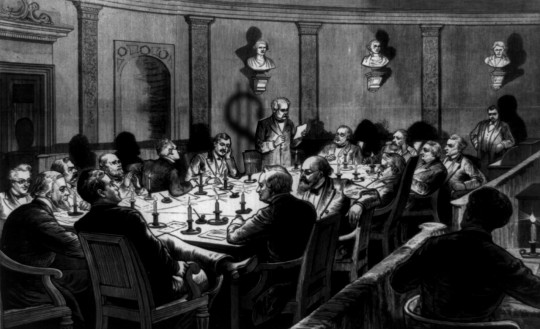
Seven years ago, I called Leonard Cohen’s Everybody Knows “the perfect anthem for our times.”
Everybody knows the war is over
Everybody knows the good guys lost
Everybody knows the fight was fixed
The poor stay poor, the rich get rich
That’s how it goes
Everybody knows
https://memex.craphound.com/2016/11/11/leonard-cohen-wrote-the-perfect-anthem-for-our-times/
If you’d like an essay-formatted version of this post to read or share, here’s a link to it on pluralistic.net, my surveillance-free, ad-free, tracker-free blog:
https://pluralistic.net/2023/03/16/compulsive-cheaters/#rigged
That was just after Cohen died, and while the world seems to want to settle on Hallelujah as his totemic song, Everybody Knows keeps inserting itself into the discourse, in the most toxic, hope-draining way possible. Whenever some awful scandal involving the great and the good breaches, we’re told that “everybody knew” already, so let’s move on.
This current has been running through our society for decades now. Remember when the Snowden leaks hit and a yawning chorus of nihilists told us that they knew already and so should anyone else with the smallest iota of sophistication? Back then Jay Rosen coined a rejoinder to this counsel of despair: “Don’t savvy me”:
https://twitter.com/jayrosen_nyu/status/344825874362810369
Everybody knows. It’s what we heard after the Panama Papers. Swissleaks. Luxleaks. The Paradise Papers. Everybody knows! It’s what the nothing-to-see-here crowd said about Propublica’s explosive IRSLeaks, back in 2021:
https://pluralistic.net/2021/06/15/guillotines-and-taxes/#carried-interest
The leaks revealed the tax-dodges of the richest and most powerful people in America, which were jaw-dropping in their audacity and shamelessness. Sure, maybe you suspected that the 400 richest people in America paid less tax than you — but did you really guess that the means by which they did this was through taking massive deductions on their elite hobbies?
https://pluralistic.net/2022/04/13/taxes-are-for-the-little-people/#leona-helmsley-2022
Maybe “everybody knows” that the game is rigged, but did you know how? Like, did you know that REITs — a tax shelter for mom-and-pop investors who buy an income property for their retirement — have become a primary vehicle for gutting unions at hotels, slashing wages and imposing brutal, dangerous working conditions?
https://pluralistic.net/2022/03/01/reit-modernization-act/#reit-makes-might
The leaks are cumulative. By combining data from one leak with another, we can build out a far more detailed picture of the conspiracy — and it is a conspiracy — among the utlrawealthy and their Renfields in the law, real-estate and accounting trades to duck their responsibilities and mound ever-more treasure on their hoards.
Take the Jersey Offshore leaks (2020), comprising the internal memos of La Hougue, a fantastically crooked firm of fixers on the Isle of Jersey, one of the lawless tax-crime jurisdictions that the UK pretends it has no control over. La Hougue has a playbook, 11 tactics for lying about your taxes. The remarkable thing about these 11 tactics is how flimsy they are, how easy it is to penetrate their lies. When Parliament says it can’t possibly do anything about the criminal havens in the Channel, remember the Jersey Offshore leaks and remind yourself that not even Parliament is that credulous. They know. Everybody knows:
https://pluralistic.net/2021/06/20/la-hougue/#complexity
Why do working people think the Democrats are just another party for the ultra-rich? Maybe it’s Pelosi’s relentless opposition to meaningful curbs on insider trading. Or maybe it’s the kinds of politicians that the Democratic Machine likes to rally behind — like Tali Farhadian Weinstein, who raised millions in 2021, in large-money donations from Democratic finance-sector donors in her bid to become the DA of Manhattan. Farhadian Weinstein and her husband have more than $100m in annual income, and yet, paid no federal tax in 2013, 2015 and 2017. In 2014, they paid $6,584:
https://pluralistic.net/2021/06/17/quis-custodiet-irs/#trumps-taxes
Propublica isn’t done with the IRS Files. Today, they published a long investigation into ultra-rich corporate executives who buy and sell their competitors’ stock for massive profits with suspiciously precise timing. The data comes from 1099-B filings, which brokerages file with the IRS with each trade, but which the IRS doesn’t share with the SEC:
https://www.propublica.org/article/secret-irs-files-trading-competitors-stock
Here are some examples:
Ohio billionaire August Troendle, CEO of Medpace, repeatedly bought and sold shares of $Syneos — his company’s archrival, timing the transactions with a management shakeup that dropped the stock by 16% in one day, and an SEC investigation that crushed Syneos’s stock by 25%. His precision timing made him at least $2.3m in profit.
Isaac Larian, CEO of Bratz-maker MGA, made $28m trading shares in Mattel, MGA’s nemesis and frequent litigant — during a period when Mattel stock crashed by 57% (!). Larian boasts that “I made a LOT more money shorting Mattel stock than they did running a $4.5 billion toy company.”
Larian’s trades also involved some very precise timing. Sometimes, he took positions just before his own company announced its upcoming products, and others positions immediately preceded major disclosures from Mattel. Larian’s subordinates told Propublica that he is “is a boss with an endless appetite for information about his company and its competitors, constantly grilling subordinates on minutiae about the industry.”
Larian couldn’t explain the timing of these trades. His lawyer told Propublica that it was “false and defamatory” to suggest that he “possessed material, nonpublic information that Larian knew was obtained in breach of a duty.”
Next up is Gerald Boelte, founder and chair of the massive oil company LLOG. LLOG partners with other companies for its oil drilling. Companies like Stone Energy. Boelte bought a huge position in Stone the day before the company’s 2015 earnings report, in which they revealed an increase their reserves’ value, pulling in a 65% one day profit. He’d never bought shares in Stone before.
Boetle told Propublica, “I do not and have never traded on any material, non-public information of competitors, business partners or others… Any implication that I was investing based upon advance knowledge is therefore clearly false.”
Jim Sankey is CEO of Invue. He bought $3.2m worth of shares in his rival Checkpoint, while checkpoint was in secret negotiations to be acquired by CCL Industries. Sankey was already thoroughly connected to Checkpoint, having sold a $150m product line to them in 2007. There’s no record that he’d ever traded Checkpoint before. He made $2.3m. Sankey says “he did not know Checkpoint was going to be acquired.” He says that his company was not approached by Checkpoint as a potential acquirer.
Barry Wish was a board member of Ocwen, a company he co-founded. After the Great Financial Crisis, Ocwen bid unsuccessfully to buy $215b worth of Bank of America mortgages. The winning bidder was Nationstar. Three weeks before Nationstar’s winning bid was announced, Wish bought $600k worth of Nationstar shares. After the bid was announced, he sold them for for a $157k profit.
Wish told Propublica that he never traded competitors’ stock: “No, not at all.” Propublica read him the details of the trade from his leaked 1099-B. He said “You might see it, but I don’t have any recollection” and hung up.
Steven Grossman is a cardboard heir — a nepobaby who inherited Southern Container Corp from his grandpa. After he sold the company to Rock-Tenn for $1b in 2013, he stayed on as a senior exec. Over the next 5 years, he traded large blocks of shares in Rock-Tenn’s competitors, companies like Temple-Inland, a company that he made a 37% profit on after its acquisition was announced in 2011, one week after Grossman started buying its shares.
Grossman falsely told Propublica, “I haven’t traded stock since then.” IRS records show that Grossman continued to trade. Grossman also told Propublica that he had no role with Rock-Tenn, despite being on their payroll for five years. When asked about his extremely lucky timing buying and selling Temple-Inland, he said “That was 10 years ago” and hung up.
As Propublica’s Robert Faturechi and Ellis Simani write, Securities regulations have their origins in the crash of 1929, and the subsequent collapse in confidence in markets and capitalism, the sense that the system was rigged for the wealthy and political insiders. That is a pretty good summation of sentiment today:
https://pluralistic.net/2023/03/15/mon-dieu-les-guillotines/#ceci-nes-pas-une-bailout
It’s not just that corporate executives are corrupt, it’s that they’re lavishly, shamelessly, endlessly, incorrigibly corrupt. Take Canadian Pacific and Kansas City Southern, the sixth- and seventh-largest Class I railroads in the USA, whose merger was just approved by the Surface Transportation Board.
There are plenty of good reasons for the STB to have blocked this merger. The rail industry is already excessively concentrated, and its top execs are so convinced that they’re both too big to fail and too big to jail that they’re rendering entire towns permanently uninhabitable in order to eke out a few more points in profit:
https://pluralistic.net/2023/02/11/dinah-wont-you-blow/#ecp
But there are specific reasons to have blocked this merger, starting with the whistleblower report about CP and KCS executives illegally coming together for a three-day “retreat” at The Breakers hotel in Palm Beach, a notorious site for Republican operatives to collude with the business lobby:
https://prospect.org/infrastructure/transportation/2023-03-16-canadian-pacific-kansas-city-southern-rail-merger/
As Luke Goldstein writes for The American Prospect, both companies spent millions in 2020 and 2022 on campaign contributions to “grease the skids” for the merger — in particular, ensuring that the combined company could transport Alberta tar sands oil (the filthiest, most energy intensive oil in the world) to US ports.
Though the STB was informed of the illegal meeting — in which the two companies behaved as though the merger had already been finalized — STB chair Martin Oberman told Goldstein that the Board did not write to the companies for an explanation before waving through their merger.
Instead, Oberman dismissed the complaint on the grounds that “Railroads have to be able to talk to one another to function.” Typically this takes place over a free phone call, though — not on a three-day executive junket at a hotel where the rooms run $1,500/night.
Oberman knows what happened at that meeting.
Everybody knows.
It comes as no surprise to learn that before FTX imploded and destroyed the savings of its depositors, it paid out $3b to its top executives, including the criminal Sam Bankman-Fried:
https://gizmodo.com/sbf-ftx-crypto-sam-bankman-fried-1850232043
It comes as no surprise that Silicon Valley Bank paid out bonuses to its execs and employees hours before it collapsed:
https://www.cnbc.com/2023/03/11/silicon-valley-bank-employees-received-bonuses-hours-before-takeover.html
Everybody knows.
It’s comforting to think that the tax code loopholes that the ultrawealthy exploit are an epiphenomenon of complexity, an unavoidable consequence of the technical requirements of a big regulation that spans 300m+ people. But the truth is, the loopholes in the US tax code were inserted by politicians who got massive campaign contributions from donors who directly benefited from those loopholes. Senator Ron Johnson got $20m from the owners of Uline (Dick and Liz Uihlein) and roofing magnate Diane Hendricks, then he blocked the Trump tax bill until his fellow lawmakers inserted a loophole that produced $215m for the Uihleins and Hendricks, in just the first year:
https://pluralistic.net/2021/08/11/the-canada-variant/#shitty-man-of-history-theory
It’s not even surprising that a sitting US Senator amended a bill to give hundreds of millions of dollars to billionaires who gave him tens of millions of dollars.
Everybody knows.
It’s weirdly comforting to think that everyday people vote for demagogue wreckers because Facebook hired a legion of evil sorcerers to fashion a mind-control ray out of Big Data and AI, but Facebook lies about everything, and everyone who ever claimed to have a mind-control ray was a liar.
Maybe people vote for demagogue wreckers because they believe the system is rotten, and maybe they believe the system is rotten because the system is rotten. Maybe the self-described evil sorcerers of Big Tech aren’t “hacking our dopamine loops” — maybe they’re just helping opportunists target people who are justifiably angry:
https://onezero.medium.com/how-to-destroy-surveillance-capitalism-8135e6744d59
The problem with this explanation is that it requires “progressive” parties to actually do stuff to demonstrate that they are on the side of people, not the side of paperclip-maximizing immortal colony organisms and the corporate executives who pretend to run them:
https://twitter.com/thehill/status/1184004730722217984
I try to have hope — that is, I try to believe that if we can only make changes to our material circumstances, however small they may seem, that we might attain a new vantagepoint that reveals more possible changes within our grasp:
https://gen.medium.com/hope-not-optimism-943e88291b
Some days, it’s hard to have hope. Some days, it’s so obvious that everybody knows, all that I can muster is fury. Fury is not a full substitute for hope, but it’ll do. It’s a far superior alternative to the fatalism that “everybody knows” and thus nothing can be done.
Some fights you win, and other fights, you just fight, because surrender isn’t an option. Everybody knows, right? If everybody knows, then everybody might just decide to do something about it.
Next Monday (Mar 20), I’m doing a remote talk for the Ostrom Workshop’s Beyond the Web Speaker Series.
[Image ID: A smoke-filled room lit by candles. Around a large formal table sit various 19th century gentlemen-type people. One of them stands and reads from a memo. The shadow he casts is in the shape of a dollar-sign.]
#pluralistic#railroads#conspiracies#insider trading#surface transportation board#kcs#kansas city southern#cpr#canadian pacific railway#irsfiles#propublica#August Troendle#Syneos#Medpace#sec#irs#MGA Entertainment#bratz#barbie#mattel#Isaac Larian#Gerald Boelte#LLOG Exploration#Stone Energy#checkpoint Systems#ccl industries#Nationstar#Ocwen#Barry Wish#Steven Grossman
51 notes
·
View notes
Text
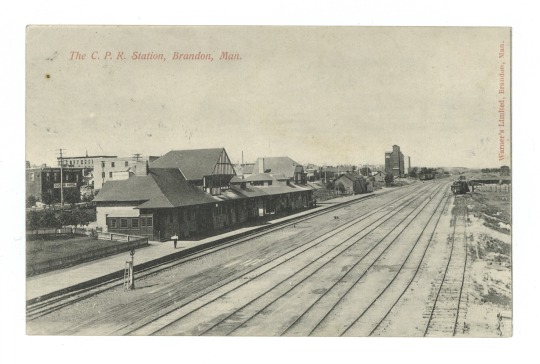
A postcard from 1906 showing the Canadian Pacific Railway station in Brandon, Manitoba. Photo source
Brandon is a true railroad town; it may never have existed without the CPR. The railroad company chose and named the townsite in 1881, electing to run the trans-continental railroad just 3.2km west of the existing settlement of Grand Valley. Today, Brandon is the second-largest city in Manitoba, while Grand Valley is a Historical Site display cairn.
10 notes
·
View notes
Text
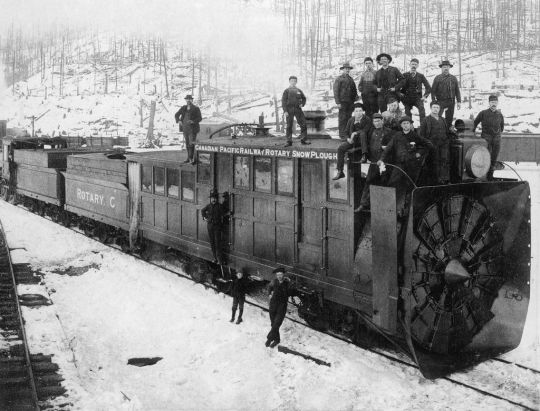
Rotary snow plow at Rogers Pass, Canadian Pacific Railway
77 notes
·
View notes
Video
Mount Temple and the Bow River from Morant’s Curve (Banff National Park) by Mark Stevens
Via Flickr:
A setting looking to the southwest while taking in views from Morant’s Curve along the Bow Valley Parkway in Banff National Park. My thought on composing this image was to pull back on the focal length and include foreground interest with the Bow River and some nearby forest. Mount Temple and other ridges and peaks of the Bow Range would be a backdrop for this setting in the Canadian Rockies.
#Alberta Provincial Highway No. 1A#Alberta and Glacier National Park#Azimuth 249#Banff National Park#Banff-Lake Louise Core Area#Blue Skies#Bow Range#Bow River#Bow Valley Parkway#Canadian Pacific Railway Track#Canadian Rockies#Day 2#DxO PhotoLab 6 Edited#Evergreen Trees#Evergreens#Forest#Forest Landscape#Hillside of Trees#Landscape#Landscape - Scenery#Little Temple#Looking SW#Morant's Curve#Mount Aberdeen#Mount Lefroy#Mount Little#Mount Temple#Mountain Peak#Mountains#Mountains in Distance
3 notes
·
View notes
Text

Canadian Pacific Rail Station, Winnipeg, taken around 1940. The building, which was the fourth railway station on the site, was built between 1904-1906, and enlarged in 1915. It operated as a railway station until 1978. It has the distinction of being the first Beaux-Arts style building in Canada. Since 1992, it’s belonged to the Neeginan Centre, or the Aboriginal Centre of Winnipeg
2 notes
·
View notes
Text

"Murdered In A Carousal At Sudbury," Cobalt Daily Nugget. September 29, 1913. Page 1.
----
Row on C.P.R. Boarding Car Ends Fatally
---
(By Canadian Press).
SUDBURY, Sept. 29. - During a carousal on a Canadian Pacific boarding car in the local yards, Mike Usolock was murdered on Saturday night by (it is is supposed) Peter Cosimer.
#sudbury#murder#carousel#railyards#fatal fight#canadian pacific railways#northern ontario#crime and punishment in canada#history of crime and punishment in canada
0 notes
Video
STL663 by Citizen of the Galaxy
Via Flickr:
The head end of eastbound NYS&W double stack train NTV-4C, on this day borrowed CP Rail power including lead SD40-2 No. 5697, crests the Erie mainline grade at Gulf Summit on the first day of February 1992, back when winter looked a little more like winter.
#nys&w#susquehanna railway#cp#canadian pacific#1992#trains#freight train#history#gulf summit#new york
27 notes
·
View notes
Text

Storm clouds brew over an iconic prairie landscape in Bulyea, Sask
#Saskatchewan#The Prairies#storm clouds#Western Canada#grain elevators#rural landscape#rural aesthetic#CNR#CPR#Canadian Pacific Railway#big sky country#weather#iconic
48 notes
·
View notes
Text

1956 Travel Canadian Pacific
Source: www.flickr.com / x-ray_delta_one
Published at: https://posterhistory.com/railroad/canadian-pacific-railway/
3 notes
·
View notes
Text
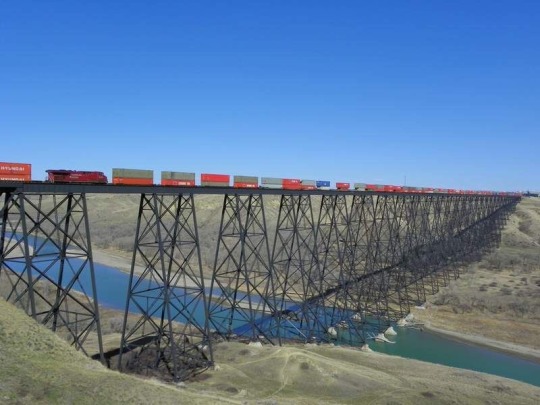
High Level Bridge (Lethbridge, Alberta)
60 notes
·
View notes

